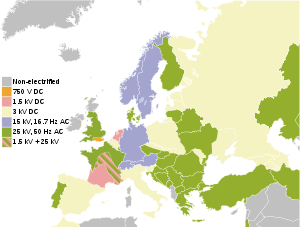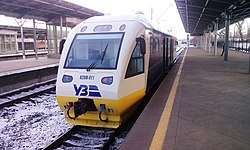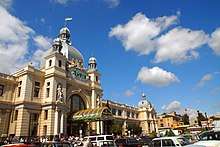Ukrainian Railways
Ukrainian Railways (Ukrainian: Укрзалізниця, Ukrzaliznytsia) is a state-owned enterprise of rail transport in Ukraine, a monopoly that controls the vast majority of the railroad transportation in the country.[nb 1] It possesses a combined total track length of over 23,000 km, making it the 13th largest in the world. Ukrainian Railways is also the world's 6th largest rail passenger transporter and world's 7th largest freight transporter.
 | |
| State-owned enterprise | |
| Industry | Railway transportation, intermodal freight transport |
| Predecessor | Ministry of the Means of Communication of the USSR, Southwestern Railways |
| Founded | 1861 (Russian Imperial Railways) 1917 (Soviet Railways) 1991 (Ukrainian Railways) |
| Headquarters | 5, Tvirska street, Kiev, Ukraine, 03680 [1] |
Number of locations | 1,700 stations and halts |
Area served | Ukraine |
Key people | Ivan Yuryk (acting CEO)[2] |
| Products | Rail transport services (passenger & cargo) |
| Revenue | |
| Owner | Ukraine (100%) |
Number of employees | 403,000 (2011) |
| Parent | Ministry of Infrastructure |
| Divisions | 6 branches (Kyiv, Donetsk, Lviv, Odesa, Kharkiv, Dnipro) |
| Website | Official website |
In 2015 Ukrainian Railways transformed through a merger of a state agency and a state-owned enterprise into a public joint stock company owned by state. Ukraine's State Administration of Railroad Transportation is subordinated to the Ministry of Infrastructure,[nb 2] administering the railways through the six territorial railway companies that immediately control and provide of all aspects of the railroad transportation and maintenance under the common Ukrzaliznytsia brand. The general director of the administration is appointed by the Cabinet of Ministers of Ukraine.[5] The gauge is 1,520 mm (4 ft 11 27⁄32 in).
The administration employs more than 403,000 people throughout the country.
Company structure and subsidiaries
Financial situation
In 2008 the Ukrainian State Railways transported around 498.5 million tonnes of domestic freight and 69.8 million tonnes of international freight through Ukrainian territory. Freight transport figures were particularly high on transport Routes 3, 5 and 9, which saw a combined total of 105 million tonnes carried in 2008. Further, Ukrzaliznytsia served around 518.8 million passengers over the course of the year. The state railways ran with an annual consolidated budget of a little more than 40 billion ₴ (US$5 billion) in 2008.
By the end of 2005 the railways had produced a profit equivalent to 1.76 billion ₴ (US$220 million) from all their operations including freight, passenger service, associated services and the operation of subsidiaries. The total capital invested in fixed assets of the State Railways is thought to be equivalent to around 22 billion ₴ (US$4.4 billion). However, depreciation of these fixed assets is estimated to be around 57%, or in terms of rolling stock, closer to 66.7%.
In 2019, Ukrainian Railway confirms intention to issue new Eurobond. Ukrainian Railway (RAILUA) has the potential to increase its debt by US$1 billion, indicating a possible Eurobond issue. Recall, Ukrainian Railway's existing US$500 million Eurobond will be amortized by US$150M both in March and September 2019 and then by US$50M semi-annually between March 2020 and September 2021. He also confirmed that Ukrainian Railway is now considering a Eurobond issue, on which he can further comment as soon as the government publishes a respective resolution (on its parameters). Kravtsov also highlighted that it's important for investors to have a clear understanding on how the borrowing will be serviced. Taking this into account, Ukrainian Railway has proposed a mechanism of automatic adjustment of freight railway rates based on Ukraine's producer price index.[6]
Ukrainian State Railways (Ukrzaliznytsia) is the fourth company of the most profitable companies in Ukraine with a revenue of UAH 74 billion.[7]
Administrative structure
.png)
The railways are split into six territorial railway companies: Donetsk, Lviv, Odessa, Southern, South-Western and Near-Dnipro. The subdivision is purely administrative as it doesn't correspond to the particular railway lines or branches. The names of regional railways are purely historic, inherited from the Russian and Austro-Hungarian Empires (for instance the 'South-Western Railway' actually operates the north-central part of Ukraine's rail network, while the 'Southern Railway' actually operates in the east of the country).
The six separate territorial railways each have their own directorates, located in the following cities:
- Donetsk Railway – Lyman (temporarily as Donetsk occupied by Russian military)
- Lviv Railway – Lviv
- Odessa Railway – Odessa
- Southern Railway – Kharkiv
- Southwestern Railway – Kiev
- Cisdnieper Railway – Dnipro
- Crimea Railway (the Cisdnieper's division has been business raided by the Russian Federation)
The territorial railways are further divided into several territorial administrations, usually four or five. Such division helps in the assignment of commuter railway lines depending on location.
Infrastructure
The full extent of railways administrated by Ukrzaliznytsia is currently around 22,300 km, of which 9,752 km (44.3%) is fully electrified with the use of the overhead wire. The network is fully interconnected, central-dispatched and consists of 1,648 stations of all sizes spread throughout the country. The largest stations are Nyzhnodniprovsk-Vuzol (in the city of Dnipro) and Darnytsia (in the capital Kiev) – both freight.
Types of stations
- Intermediate
- Sorting
- Freight
- Sectional
- Passenger
Railway stations also have five classes depending on their general performance. Some stations may be named as railway stop, platform number, passing loop (Ukrainian: роз'їзд) or simply kilometer post.
Stations
Upgrading and expansions
The Ukrainian railway network is permanently undergoing large scale reconstruction, mainly in order to reduce operating costs inherited from the Soviet economy and to implement higher speeds of passenger services. Around 4000 track switches have already been upgraded.
Rolling stock
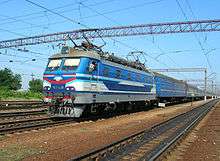

Ukrzaliznytsia has several repair factories capable of producing locomotives and railcars. In addition there is a separate Kryukiv Railcar Engineering Factory and Dnieper Railcar Engineering that also produce railroad rolling stock for Ukrzaliznytsia and other companies for public transportation.
In November 2010, UZ agreed to buy 10 high-speed HRCS2 multiple unit interurban trainsets from Hyundai Rotem, with the prospect of a much larger order or joint venture for local production.[8] The first two trains would be delivered in February 2012, two more in April and another two in May, when they will start operating.[9] They will be rated as Inter City+ and will be connecting Kiev with Kharkiv, Donetsk and Lviv, and at a later stage with Dnipro and Odesa.[10]
In July 2011 UZ announced plans to buy 433 electric freight locomotives; 292 2EL4s from Transmashholding, and 141 locomotives (including class VL11M/6) from Elmavalmshenebeli.[11] Due to the 2014 Russian invasion of Ukraine Transmashholding was put on a sanctions list.[12]
Because of the War in Donbass, some factories that were producing locomotives and railcars were lost, such as Luhanskteplovoz (Luhansk Diesel Locomotive) and Stakhanov Railcar Engineering.
In December 2017, UZ and GE Transportation agreed a to strategic partnership for the implementation of a 7-year rolling stock renewal program including the delivery of 30 locomotives to Ukrzaliznytsia in September 2018 with 40% manufactured in Ukraine.[13]
Main line and long-distance services
| Service | Rolling stock | Route | Number | Image |
|---|---|---|---|---|
| Intercity and Intercity+
Managed by Ukrainian Railway High-Speed Company |
HYUNDAI Rotem HRCS2 | 10 | ||
| Skoda EJ 675 | 2 | 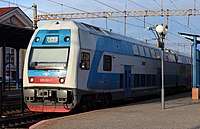 | ||
| EKr1 | 2 | 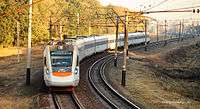 |
Statistics
Acting head of Ukrzaliznytsia, Yevhen Kravtsov, reported on December 2017 that his company had a whole fleet of 25,000 rail cars.[14]
Main statistics:[15]
- Main track running length - 19,790 km
- Electrified track - 9,926 km (47.4%)
- Number of railway stations - 1,447
- Number of freight (goods) wagons – 84,000 (working - 65,000)
- Number of passenger cars – 4,540 (working - 3,100)
- Number of diesel locomotives – 1,936
- Number of electric locomotives – 1,628
- Number of specially branded passenger trains – 50
- Number of employees (26.01.2018) - 276,119 people.
- Passengers carried for 2017 - 206.6 million.
- Cargo transportation for 2017 - 339.5 million tons.
Criticism
The problems of the railway transport in Ukraine are:
- imperfection of the regulatory acts regulating the activity of rail transport, and the inconsistency of its organizational structure with the conditions for the development of the market economy of the country;
- cross-subsidization of unprofitable passenger transportation at the expense of freight;
- lack of transparency in the financial sector;
- low competition in the rail transport market.[16]
The existing structure of rail transport management, the state of the production and technical base of railways and the technological level of organization of transportation do not meet the growing needs of society and the European standards of quality of transport services.[17]
Classification of passenger trains (railway lines)
Railway lines are classified into commuter, regional, Intercity and EuroCity. Daytime trains are also distinguished into a separate class from those that run at night. Intercity lines are coded with single, double and triple digits. while commuter lines are coded with quadruple digits.
On 27 April 2011 in accordance with order No. 504/2011 rail industry specialists developed a new classification system of passenger trains for Ukrainian Railways.[18]
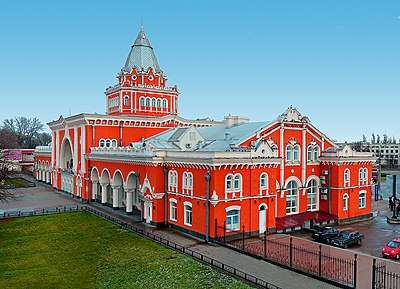
The development of a new classification system for passenger trains in Ukraine was made necessary by the need to inform customers (passengers) about the level of service quality they could expect to find in various passenger trains. The new system is based on the class of train and carriages.
Given the quality of the service provided UZ asked the following classes of passenger trains:
- Daytime passenger lines:
- Euro City (EC) – Express (min. 90 km/h) daytime services on international routes which should offer a very high level of service and comfort. First and standard classes.
- Inter City+ (IC+) – Express (min. 90 km/h) daytime services on domestic routes which should offer a very high level of service and comfort. First and standard classes. These services are currently operated by Hyundai Rotem HRCS2 multiple unit trains on routes between Kyiv and Kharkiv, Lviv, Dnipro, Zaporizhzhia, Pokrovsk, Kryvyi Rih, Konstantinivka (Ukraine), Odesa, Ternopil, Kropyvnytskyi. Besides, there is one international express Kyiv - Peremyshl (Poland).[19]
- Inter City (IC) – (max. 70 km/h – 90 km/h) daytime services on domestic routes which should offer a heightened level of service and comfort. First, standard and economy classes. These services are currently operated by Škoda UZ class 675 trains on routes between Kharkiv, Dnipro and Donetsk.
- Regional Express (РЕ) – (max. 70 km/h – 90 km/h) daytime services on domestic routes which should offer a standard level of service and comfort. First, standard and economy classes.
- Regional train (РП) – (max. 70 km/h) daytime services on domestic routes which should offer a standard level of service and comfort. Standard and economy classes.
- Nighttime passenger trains:
- Euro Night (EN) – Express (min. 90 km/h) nighttime services on international routes which should offer a very high level of service and comfort. 2 berth coupe and 4 berth coupe classes.
- Night Express (НЕ) (max. 70 km/h – 90 km/h) nighttime services on international and domestic routes which should offer a heightened level of service and comfort. 2 berth coupe, 4 berth coupe and platskarta classes.
- Night fast (НШ) – (max. 50 km/h – 70 km/h) nighttime services on international and domestic routes which should offer a heightened level of service and comfort. 2 berth coupe, 4 berth coupe and platskarta classes.
- Night passenger (НП) (max. 50 km/h) nighttime services on international and domestic routes which should offer a heightened level of service and comfort. 4 berth coupe and platskarta classes.
The advantages of the new classification system include full compliance with the classification of the European Union, compliance with Ukrainian and English names and abbreviations, linguistic and semantic consistency and clarity for customers in Ukraine and compatibility with existing and future tariff policy. The system is also not far displaced from the previous classification system used for passenger trains on the territory of Ukraine.
Subsidiaries and partners
Factories
- Darnytsia railcar maintenance shop
- Popasna railcar maintenance shop
- Stryi railcar maintenance shop
- Hnivan factory of special reinforced concrete
- Korosten factory of reinforced concrete railroad ties
- Kremechuk factory of reinforced concrete railroad ties
- Starokostyantyniv factory of reinforced concrete railroad ties
Producing companies
- Ukrzaliznychpostach
- Vinnytsiatransprylad
- Ukrainian state center of railroad refrigerated transportation
- Ukrainian state center in exploitation of specialized rolling stock "Ukrspecrailcar"
Others
- Central station of communication
- Donbasshlyakhpostach
- Main information-calculation center
- Ukrainian state accounting center of international transportations
- State company "Ukrainian center of track works mechanization"
- Lisky
- Ukrainian center of passenger service (UTsOP)
- Ukrtransfarmatsia
- E-kvytok (translate Electronic ticket)
Rail links with adjacent countries
- Same gauge:
 Most commonly used rail gauges in the countries of Eurasia. ----Railway network based on the 1520 mm gauge
Most commonly used rail gauges in the countries of Eurasia. ----Railway network based on the 1520 mm gauge - break-of-gauge: 1,520 mm (4 ft 11 27⁄32 in)/1,435 mm (4 ft 8 1⁄2 in)




Education
The National Railway University in Dnipro currently has 10 faculties as well as a technical school, a business school and branches in Odesa and Lviv, 450 professors and 39 separate fields of study related to railway transport.
Directors
.svg.png)

- President
- 1991-1993 Borys Oliynyk
- General director
- 1993-1997 Leonid Zheleznyak
- 1997-2000 Anatoliy Slobodyan
- 2000-2004 Heorhiy Kirpa
- 2005-2005 Volodymyr Korniyenko
- 2005-2005 Zenko Aftanaziv
- 2005-2006 Vasyl Hladkikh
- 2006-2007 Volodymyr Kozak
- 2007-2007 Petro Naumenko
- 2007-2008 Vasyl Melnychuk
- 2008-2011 Mykhailo Kostiuk
- 2011-2012 Volodymyr Kozak
- 2013-2014 Serhiy Bolobolin
- 2014-2014 Borys Ostapyuk
- 2014-2015 Maksym Blank (acting)
- 2015-2015 Oleksandr Zavhorodniy (acting)
- Board director
Notes
- Except for intra-company industrial railways, local military railways and municipal Metro systems.
- Previously, before December 2010 cabinet reform – to the Ministry of Transportation and Communication.
References
- "Official website. Address (bottom of the page)". March 2017.
- (in Ukrainian) Cabinet replaces Ukrzaliznytsia interim chief, Ukrayinska Pravda (15 April 2020)
- http://uz.gov.ua/press_center/up_to_date_topic/470074/
- http://www.uz.gov.ua/files/file/about/investors/%D0%9F%D0%90%D0%A2%20%D0%A3%D0%BA%D1%80%D0%B7%D0%B0%D0%BB%D1%96%D0%B7%D0%BD%D0%B8%D1%86%D1%8F%20%D0%9A%D0%BE%D0%BD%D1%81%D0%BE%D0%BB%D1%96%D0%B4%D0%BE%D0%B2%D0%B0%D0%BD%D0%B0%20%D1%84%D1%96%D0%BD%D0%B0%D0%BD%D1%81%D0%BE%D0%B2%D0%B0%20%D0%B7%D0%B2%D1%96%D1%82%D0%BD%D1%96%D1%81%D1%82%D1%8C%202017%20%D0%B7%D1%96%20%D0%B7%D0%B2%D1%96%D1%82%D0%BE%D0%BC%20%D0%B0%D1%83%D0%B4%D0%B8%D1%82%D0%BE%D1%80%D0%B0.pdf
- (in Ukrainian) "КАБІНЕТ МІНІСТРІВ УКРАЇНИ П О С Т А Н О В А від від 29 лютого 1996 р. N 262". Законодавство України. 21 November 2008.
- "Ukrainian Railway confirms intention to issue new Eurobond". inventure.com.ua. Retrieved 31 July 2019.
- БизнесЦензор. "200 найбільших компаній України 2017 року". БизнесЦензор (in Russian). Retrieved 13 September 2019.
- "UZ to order Korean trainsets". Railway Gazette. 17 November 2010.
- "Six high-speed Hyundai trains to come to Ukraine by 10 May". Information сentre "Ukraine-2012". 7 February 2012.
- "4 Hyundai Rotem trains to serve on the route Kyiv – Dnipropetrovsk, Kyiv – Odesa after EURO 2012". Context-Prichernomorie. 7 February 2012.
- "Ukrainian Railways agrees locomotive orders worth €1·46bn". Railway Gazette. 3 August 2011.
- Olekhov, Ihor (20 October 2016). "Ukraine Expands Sanctions against Russia". globalcompliancenews.com. Retrieved 9 April 2018.
- GE Transportation to deliver 30 locomotives to Ukrzaliznytsia in Sep 2018, UNIAN (4 December 2017)
- Week’s balance: easing for businesses, hryvnia drop, and slap in Gazprom’s face in Stockholm, UNIAN (23 December 2017)
- "Статистичні дані про Українські залізниці". Міністерство інфраструктури України (in Ukrainian). Retrieved 13 September 2019.
- "Підготовлено проект нової системи класифікаці ї пасажирських поїздів". Укрзалізниці.
- "Маршрути швидкісних поїздів у 2019 році. Інфографіка". www.ukrinform.ua (in Ukrainian). Retrieved 13 September 2019.
- Cabinet appoints Polish citizen Wojciech Balczun head of Ukrzaliznytsia, Interfax-Ukraine (20 April 2016)
One of Poland's most successful transport managers to chair Ukrainian Railways, Ukraine Today (12 April 2016) - Poland's Balczun sums up his work as Ukrzaliznytsia CEO, UNIAN (9 August 2017)
- (in Ukrainian) "Ukrzaliznytsia" was temporarily headed by Marček Zhelko, UNIAN (5 February 2020)
External links
| Wikimedia Commons has media related to Ukrainian Railways. |
- Official website
- "Online ticket purchases". booking.uz.gov.ua.
